|
||||||||||
|
|
||||||||||
|
||||||||||
|
|
||||||||||
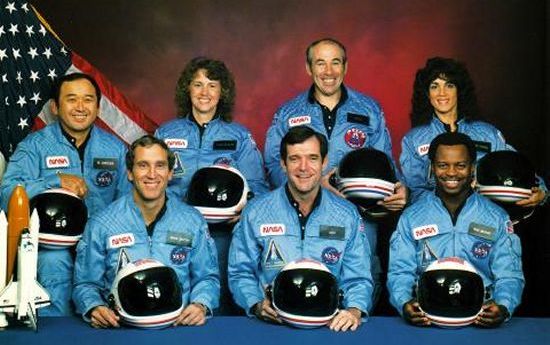
It was several weeks into the recovery effort when divers discovered a large pile of debris about 100 ft (30 m) deep on the ocean floor. This debris turned out to be what was left of Challenger's crew cabin. The Presidential Commission organized to investigate the accident later determined that the Orbiter's forward fuselage had separated from the rest of the vehicle during the Shuttle's break-up about 75 seconds into the flight. As it separated, the forward fuselage tore a collection of wiring harnesses and other connections loose from the aft portion of the Orbiter. These long cables trailed behind the crew compartment and prevented it from tumbling, stabilizing the cabin much like the tail of a kite.
The Shuttle had broken apart at an altitude of about 46,000 ft (14,035 m). Following its separation, the crew compartment stabilized in a nose-down attitude within 10 to 20 seconds as its forward momentum carried it upward to some 64,000 ft (19,525 m). The cabin then began a free-fall towards the ocean, yawing back and forth slightly during its ballistic trajectory. The free-fall lasted about two minutes and 45 seconds until the compartment impacted on the ocean surface. At an estimated speed of 207 mph (333 km/h), the cabin shattered due to the 200 g's it experienced. The broken debris fell to the ocean floor and scattered over an oval field about 60 ft (18 m) across.
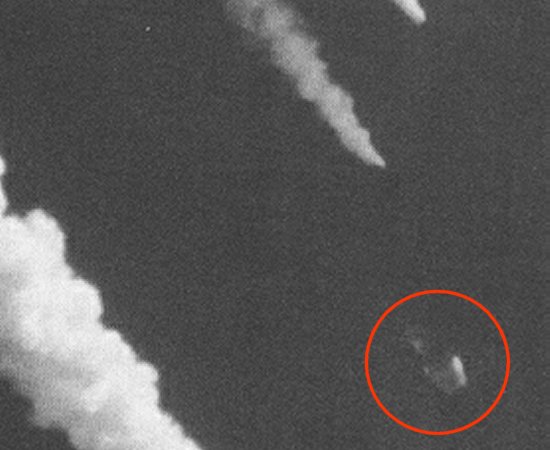
Despite this violent chain of events, the question has always remained as to whether the crew remained alive and aware of what was happening as their tragic fate approached. Rumors began almost immediately after the accident when NASA officials were accused of lying and concealing evidence that the astronauts were still conscious at the time of the crew cabin's impact. The "transcript" you mention became a primary piece of evidence conspiracy theorists used to support their claims of a NASA cover-up. A common example of this rumor is shown below.
|
A secret NASA tape reveals that the crew of the shuttle Challenger not only survived the explosion that
ripped the vessel apart; they screamed, cried, cursed and prayed for three hellish minutes before they
slammed into the Atlantic and perished on January 28, 1986.
The tape is said to begin with a startled crewman screaming, "What happened? What happened? Oh God - No!" Screams and curses are heard - several crewmen begin to weep - and then others bid their families farewell. Two minutes forty-five seconds later the tape ends. That's when the shuttles crew compartment, which remained intact after the vessel exploded over the Atlantic, hit the ocean at over 2,000 miles per hour, instantly killing the crew. "Cover up? Of course there was a coverup," declared Robert Hotz, a member of the Presidential commission that investigated the disaster." NASA can't face the fact that they put these astronauts in a situation where they didn't have adequate equipment to survive. NASA doesn't give a damn about anything but covering its ass," he said. The official account released by NASA ends with shuttle pilot Michael Smith saying, " Uh-oh! " Some NASA employees have evidently heard more-much more. And they provided the rest of the account based on what they've discussed within NASA in the last five years. The astronauts had time and realized something was happening after the shuttle broke up. "All shuttle astronauts carry personal recorders and the tape in question apparently came from Christa's (McAuliffe), which was recovered after the shuttle disaster," said Hotz. Jarvis was sitting beside her, and when he figured out what was happening he said, "Give me your hand." "NASA insists there's nothing like that on tape but they're talking about the mission tape, not Christa's. So they're not lying, but they're not telling the truth, either." A journalist with close ties to NASA was even more emphatic, "There are persistent rumors, dating back to the disaster, that this tape is absolutely bone-chilling." The following transcript begins two seconds after NASA's official version ends, with pilot Michael Smith saying, "Uh-oh!" Times from the moment of takeoff are shown in minutes and seconds and are approximate. The sex of the speaker is indicated by M or F. T+1:15 (M) What happened? What happened? Oh God, no - no! T+1:17 (F) Oh dear God. T+1:18 (M) Turn on your air pack! Turn on your air... T+1:20 (M) Can't breathe... choking... T+1:21 (M) Lift up your visor! T+1:22 (M/F) (Screams.) It's hot. (Sobs.) I can't. Don't tell me... God! Do it...now... T+1:24 (M) I told them... I told them... Dammit! Resnik don't... T+1:27 (M) Take it easy! Move (unintelligible)... T+1:28 (F) Don't let me die like this. Not now. Not here... T+1:31 (M) Your arm... no... I (extended garble, static) T+1:36 (F) I'm... passing... out... T+1:37 (M) We're not dead yet. T+1:40 (M) If you ever wanted (unintelligible) me a miracle... (unintelligible)... (screams) T+1:41 (M) She's... she's... (garble) ... damn! T+1:50 (M) Can't breathe... T+1:51 (M/F) (screams) Jesus Christ! No! T+1:54 (M) She's out. T+1:55 (M) Lucky... (unintelligible). T+1:56 (M) God. The water... we're dead! (screams) T+2:00 (F) Goodbye (sobs)... I love you, I love you... T+2:03 (M) Loosen up... loosen up... T+2:07 (M) It'll just be like a ditch landing... T+2:09 (M) That's right, think positive. T+2:11 (M) Ditch procedure... T+2:14 (M) No way! T+2:17 (M) Give me your hand... T+2:19 (M) You awake in there? I... I... T+2:29 (M) Our Father... (unintelligible)... T+2:42 (M) ...hallowed be Thy name... (unintelligible). T+2:57 (M) You...over there? T+2:58 (M) The Lord is my shepherd, I shall...not want. He maketh me to lie down in green pastures... though I walk through the valley of the shadow of death, I will fear no evil... I will dwell in the house... T+3:15 to end None. Static, silence.Rest in Peace |
Unfortunately for believers, this "transcript" is actually a hoax. It first appeared in a February 1991 issue of the tabloid newspaper Weekly World News. Anyone familiar with this tabloid knows that it is hardly a credible source of information and is best known for creating rather ridiculous and comical headlines based on nothing but pure imagination. Since it first appeared, the falsified transcript has become separated from its original source of questionable integrity and been perpetuated thanks to the internet.
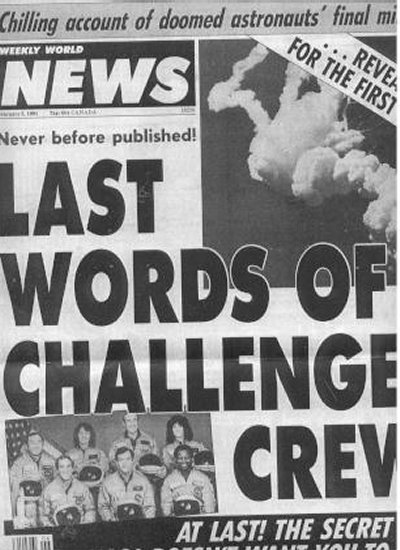
Not only is the transcript itself a work of fiction, but many of the details describing where it came from are simply not possible. For example, the Weekly World News article states that the recording was made by a personal recorder carried by Christa McAuliffe. While astronauts are regularly equipped with small tape recorders for taking notes, they are stowed in equipment lockers during launch. Only one personal recorder was recovered after the accident and it had not been removed from its storage container.
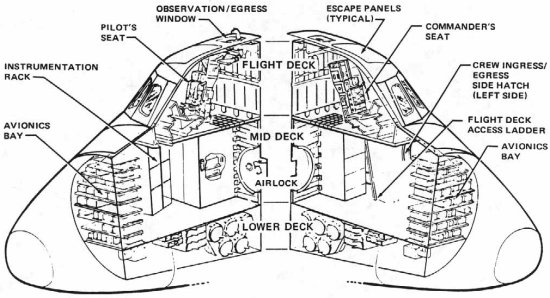
The transcript also contains at least one quote that seemingly refers to Judy Resnick while another quote is said to come from Greg Jarvis. Even if Christa McAuliffe was carrying a personal recorder, it would have been impossible for her to communicate with both of these astronauts since they were seated on different decks. Mission commander Scobee, pilot Smith, Onizuka, and Resnik were located on the flight deck while McAuliffe, Jarvis, and McNair were seated one deck below on the mid deck. Those on different decks would not have been able to talk to or hear each other after the Orbiter broke apart.
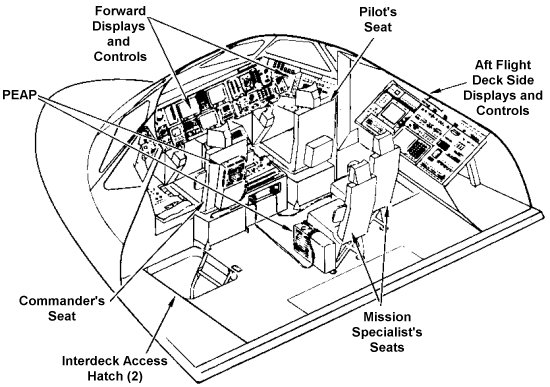
The crew communicated by means of an intercom system, but this system would no longer have functioned since the cabin lost electrical power after it separated from the rest of the Orbiter. The power supply is located aft of the crew compartment in the midfuselage, underneath the payload bay. All power was abruptly lost once the crew cabin broke loose from the rest of the Orbiter. Without the intercom and with their words muffled by their helmets, it would have been extremely difficult for the astronauts to talk to anyone, except perhaps their immediate neighbors if they were able to open their visors. Furthermore, the wreckage of the crew cabin remained on the ocean floor for six weeks until it was recovered. Any unprotected audio tapes would not have survived that length of time immersed in sea water, assuming they would have even survived the 200 g impact to begin with.

The article does contain elements of truth, however. For example, the Shuttle was equipped with a voice recording device that did survive. This was the operational data recorder that is similar in design and purpose to the cockpit voice recorder carried aboard commercial aircraft. This device recorded all comments made over the Shuttle's intercom system and was successfully recovered after the accident. The recorder worked exactly as it was supposed to from the time it was automatically activated about two minutes prior to launch until it lost power as the craft broke apart. The following is the actual transcript of the crew's conversations as obtained from the operational recorder. The transcript only contains the conversation of the four astronauts on the flight deck. While the three on the mid deck were also on the same intercom, they made no comments while the recorder was functioning.
Crew Members CDR.....Scobee PLT.....Smith MS1.....Onizuka MS2.....Resnik The references to "NASA" indicate explanatory references NASA provided to the Presidential Commission. Time Crew Crew (Min:Sec) Member Comment T-2:05 MS2 Would you give that back to me? T-2:03 MS2 Security blanket. T-2:02 MS2 Hmm. T-1:58 CDR Two minutes downstairs; you gotta watch running down there? (NASA: Two minutes until launch.) T-1:47 PLT OK there goes the lox arm. (NASA: Liquid oxygen supply arm to ET.) T-1:46 CDR Goes the beanie cap. (NASA: Liquid oxygen vent cap.) T-1:44 MS1 Doesn't it go the other way? T-1:42 Laughter. T-1:39 MS1 Now I see it; I see it. T-1:39 PLT God I hope not Ellison. T-1:38 MS1 I couldn't see it moving; it was behind the center screen. (NASA: Obstructed view of liquid oxygen supply arm.) T-1:33 MS2 Got your harnesses locked? (NASA: Seat restraints.) T-1:29 PLT What for? T-1:28 CDR I won't lock mine; I might have to reach something. T-1:24 PLT Ooh kaaaay. T-1:04 MS1 Dick's thinking of somebody there. T-1:03 CDR Unhuh. T-59 CDR One minute downstairs. (NASA: One minute until launch.) T-52 MS2 Cabin Pressure is probably going to give us an alarm. (NASA: Caution and warning alarm. Routine occurrence during prelaunch.) T-50 CDR OK. T-47 CDR OK there. T-43 PLT Alarm looks good. (NASA: Cabin pressure is acceptable.) T-42 CDR OK. T-40 PLT Ullage pressures are up. (NASA: External tank ullage pressure.) T-34 PLT Right engine helium tank is just a little bit low. (NASA: SSME supply helium pressure.) T-32 CDR It was yesterday, too. T-31 PLT OK. T-30 CDR Thirty seconds down there. (NASA: 30 seconds until launch.) T-25 PLT Remember the red button when you make a roll call. (NASA: Precautionary reminder for communications configuration.) T-23 CDR I won't do that; thanks a lot. T-15 CDR Fifteen. (NASA: 15 seconds until launch.) T-6 CDR There they go guys. (NASA: SSME Ignition.) MS2 All right. CDR Three at a hundred. (NASA: SSME thrust level at 100% for all 3 engines.) T+O MS2 Aaall riiight. T+1 PLT Here we go. (NASA: Vehicle motion.) T+7 CDR Houston, Challenger roll program. (NASA: Initiation of vehicle roll program.) T+11 PLT Go you Mother. T+14 MS1 LVLH. (NASA: Reminder for cockpit switch configuration change. Local vertical/local horizontal.) T+15 MS2 (Expletive) hot. T+16 CDR Ooohh-kaaay. T+19 PLT Looks like we've got a lotta wind here today. T+20 CDR Yeah. T+22 CDR It's a little hard to see out my window here. T+28 PLT There's ten thousand feet and Mach point five. (NASA: Altitude and velocity report.) T+30 Garble. T+35 CDR Point nine. (NASA: Velocity report, 0.9 Mach.) T+40 PLT There's Mach one. (NASA: Velocity report, 1.0 Mach.) T+41 CDR Going through nineteen thousand. (NASA: Altitude report, 19,000 ft.) T+43 CDR OK we're throttling down. (NASA: Normal SSME thrust reduction during maximum dynamic pressure region.) T+57 CDR Throttling up. (NASA: Throttle up to 104% after maximum dynamic pressure.) T+58 PLT Throttle up. T+59 CDR Roger. T+60 PLT Feel that mother go. T+60 Woooohoooo. T+1:02 PLT Thirty-five thousand going through one point five. (NASA: Altitude and velocity report, 35,000 ft., 1.5 Mach.) T+1:05 CDR Reading four eighty six on mine. (NASA: Routine airspeed indicator check.) T+1:07 PLT Yep, that's what I've got, too. T+1:10 CDR Roger, go at throttle up. (NASA: SSME at 104 percent.) T+1:13 PLT Uhoh. T+1:13 LOSS OF ALL DATA. |
(Learn more about the data recorders aboard the Space Shuttle, how their power supplies function, and the effort to recover transcripts from Challenger by reading these descriptions from NASA experts.)
Even though the heart of the Weekly World News "transcript" has been exposed as the forgery it is, the article does raise legitimate questions about whether or not the crew survived the initial break-up of the Orbiter and its descent back to Earth. The person given responsibility for investigating this subject was NASA's director of Life Sciences Dr. Joseph Kerwin. The results of his medical investigation and autopsies of the crew were documented in a July 1986 report. Kerwin's report addresses the following primary questions:
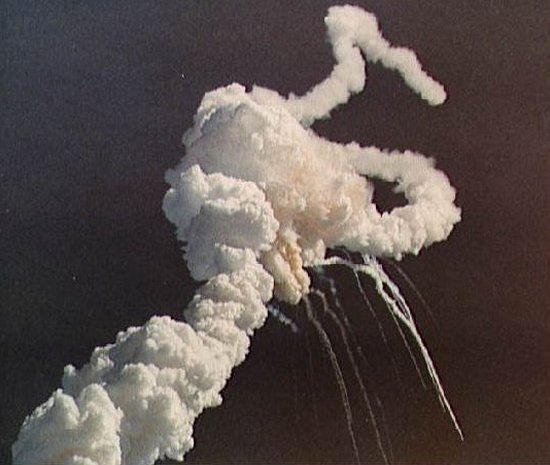
Even though the crew would likely have survived the disintegration of the Orbiter, however, it is more difficult to determine whether they remained conscious. The Shuttle broke apart around 46,000 ft (14,035 m) where the external air is only about 18% as dense as it is at sea level. The crew cabin continued to rise another 18,000 ft (5,485 m) after it broke free where the atmospheric density drops below 8% of its sea level value. There is so little oxygen at these altitudes that a human would pass out in no more than five to fifteen seconds, and the cabin remained at or above 46,000 ft for nearly one minute. If the cabin retained its airtight integrity, however, the crew would likely have had sufficient oxygen to remain conscious even at these extreme heights.
Much of Dr. Kerwin's investigation focused on whether the crew compartment did indeed remain pressurized during its free-fall or decompressed so rapidly that the crew would have passed out. Unfortunately, this question was particularly difficult to answer given the state of the wreckage that was recovered. On one hand, the sheer number of connections that ripped loose as the crew cabin separated from the Orbiter ought to have provided multiple paths for air to leak out of the compartment. If the damage allowed air to escape rapidly while the cabin was still at high altitudes, it is likely that the astronauts would have passed out within a matter of seconds. Kerwin did find evidence consistent with a rapid decompression that would have incapacitated the crew quickly, but there was no conclusive proof to confirm or refute it. The violence of the compartment's impact on the ocean surface combined with the six weeks the wreckage and remains spent submerged in sea water made it impossible to determine whether the cabin retained pressure or precisely when and how the astronauts lost their lives.
One of the most intriguing clues as to the crew's fate was the recovery of several Personal Egress Air Packs (PEAPs). The PEAPs provided the astronauts with a supply of oxygen in the case of an emergency. Four PEAPs were recovered from the ocean floor, and three had been manually activated and partly consumed. Those believing in a cover-up point to this fact as proof that at least three crew members remained conscious throughout the descent. That argument does not necessarily hold up, however, since the primary purpose of the PEAPs was to provide breathable air in the case of an emergency on the launch pad where atmospheric pressure is high. The PEAPs were not intended for high-altitude use and the crew were not wearing oxygen masks or pressure suits to function in the thin atmosphere to which they may have been exposed. The fact that the fourth PEAP was not activated suggests that the astronauts may have been attempting to turn these devices on at the same time as the effects of oxygen deprivation were causing them to lose consciousness. Since the PEAPs were not designed to function in the low density atmosphere above 20,000 ft (6,100 m), the air they provided would have rapidly dissipated and not prevented the crew from passing out.
Dr. Kerwin ultimately came to a similar conclusion. Based on his examination of the crew cabin wreckage, data recorders, imagery of the cabin during its descent, and the crew's remains, he determined that the astronauts were probably unconscious and unable to communicate during their final minutes. Kerwin's report stated, "The cause of death of the Challenger astronauts cannot be positively determined, the forces to which the crew were exposed during the orbiter breakup were probably not sufficient to cause death or serious injury, and the crew possibly, but not certainly, lost consciousness in the seconds following orbiter breakup due to in-flight loss of crew module pressure."

It is unfortunate, though not surprising, that NASA received so much criticism for its handling of the Challenger accident. Much of it was self-inflicted by the agency's attitudes of secrecy, such as fighting court battles to keep photos of wreckage out of the media and refusing to allow an autopsy of the crew's remains by the county coroner. It is likely that NASA did so in order to protect the families of the astronauts from further grief and limit additional damage to the agency's own reputation.
However, NASA's actions probably only worsened its credibility and came under intense attack by Robert Hotz. Mentioned in the Weekly World News article, Hotz is indeed a real person and served as a member of the Commission that investigated the Challenger tragedy. Hotz had previously been editor-in-chief of the respected publication Aviation Week and Space Technology. Although it seems unlikely that someone of his professional stature would use the harsh and often crude language quoted by the Weekly World News, his quotes do indeed appear to be legitimate. More credible publications have contained even worse expletives that Hotz has hurled at NASA regarding both the Challenger and Columbia investigations.
It was because of NASA's perceived evasiveness that rumors like the fake transcript found such acceptance in the
conspiracy community. Yet regardless of how the brave astronauts faced their tragic ends, this forged "transcript"
does not record their final words and does little to honor their memories.
- answer by Jeff Scott, 22 January 2006
Read More Articles:


|
Aircraft | Design | Ask Us | Shop | Search |

|
|
| About Us | Contact Us | Copyright © 1997-2023 | |||
|
|
|||